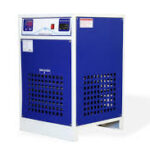Online Chiller
Online Chiller is a refrigeration system designed to provide continuous cooling for industrial or commercial applications. It is equipped with capabilities for remote monitoring and control through internet connectivity, allowing operators to adjust settings, monitor performance, and receive alerts from anywhere. Online chillers are crucial in maintaining stable temperatures for sensitive equipment, processes, or environments, ensuring efficient operation and minimizing downtime.
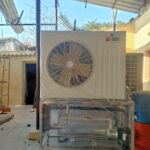
Online Chiller
Benefits of
- Remote Monitoring and Control: Allows operators to monitor chiller performance, adjust settings, and receive alerts remotely via internet connectivity, enhancing operational efficiency and responsiveness.
- Improved Reliability: Continuous monitoring helps in early detection of issues, reducing downtime and enhancing reliability of cooling processes.
- Energy Efficiency: Advanced controls optimize chiller operation based on real-time data, improving energy efficiency and reducing operational costs.
- Consistent Performance: Maintains stable temperatures for critical processes or equipment, ensuring consistent performance and product quality.
- Maintenance Optimization: Enables proactive maintenance scheduling and troubleshooting, prolonging equipment lifespan and reducing unexpected breakdowns.
- Data Logging and Analysis: Captures operational data for analysis, facilitating performance optimization and predictive maintenance strategies.
- Flexibility and Scalability: Supports integration with other systems and scalability to meet changing cooling demands and operational requirements.
- Environmental Compliance: Modern online chillers often use eco-friendly refrigerants and efficient cooling technologies, contributing to sustainability goals and regulatory compliance.
Online Chiller
Components of
- ompressor: Responsible for circulating refrigerant through the system, compressing it to increase its temperature and pressure.
- Condenser: Converts the high-pressure, high-temperature refrigerant vapor into a liquid by transferring heat to a cooling medium (air or water).
- Evaporator: Absorbs heat from the process fluid (air, water, or other fluids) to be cooled, causing the refrigerant to evaporate and return to the compressor.
- Expansion Valve: Regulates the flow of refrigerant into the evaporator, controlling its pressure and temperature.
- Refrigerant: Circulates through the system, absorbing and releasing heat to achieve the cooling effect.
- Control System: Includes sensors, controllers, and human-machine interfaces (HMIs) for monitoring and adjusting chiller operation parameters such as temperature, pressure, and flow rates.
- Pumps: Circulate process fluid through the evaporator and condenser for heat exchange with the refrigerant.
- Fans: Assist in dissipating heat from the condenser (air-cooled chillers) or circulating air through the evaporator (air-cooled or water-cooled chillers).
- Heat Exchangers: Facilitate heat transfer between the refrigerant and the process fluid (air or water), ensuring efficient cooling.
- Filters and Driers: Remove contaminants and moisture from the refrigerant to maintain system cleanliness and performance.
Online Chiller
Features of
- Remote Monitoring and Control: Integration with IoT (Internet of Things) platforms for remote access, monitoring, and control via mobile devices or web interfaces.
- Advanced Controls: Programmable logic controllers (PLCs) or microprocessor-based controllers for precise operation and optimization of cooling parameters.
- Energy Management Systems: Integration with energy management systems to optimize chiller operation based on energy demand and cost.
- Fault Diagnosis and Alarms: Built-in diagnostic tools and alarms for early detection of faults, with notifications sent to maintenance personnel or operators.
- Variable Speed Drives (VSDs): Adjustable speed drives for compressors, pumps, or fans to match cooling demand, improving energy efficiency.
Other Chiller Products We Manufacture
Air Cooled Chiller
Air-cooled chillers are refrigeration systems that use air to dissipate heat from the coolant or refrigerant. Unlike water-cooled chiller, which rely on a water source and cooling towers
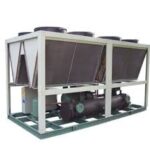
Water Cooled Chiller
Water Cooled Chillers are refrigeration systems that use water as a cooling medium to transfer heat away from the refrigerant. They are widely used in large-scale industrial

Screw Chiller
Screw Chillers are a type of refrigeration system used for air conditioning or industrial cooling applications. They operate using screw compressors, which are efficient at handling large cooling loads.
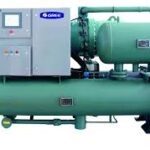
Variable Speed Chiller
Variable Speed Chillers are refrigeration systems equipped with compressors that have variable frequency drives (VFDs). These drives enable the compressor motor to adjust its speed according to the cooling load demand.
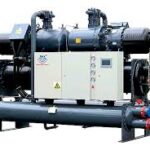
Oil Chiller
Oil Chiller are refrigeration systems designed to control and maintain the temperature of lubricating oil used in industrial machinery and processes. They ensure that the oil remains within a specified temperature range
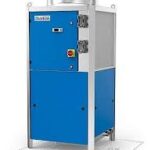
Hydraulic Oil Chiller
Hydraulic Oil Chillers are specialized refrigeration systems designed to cool and maintain the temperature of hydraulic oil used in hydraulic systems. They ensure that the oil remains within a specified temperature range
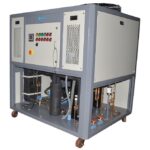
Glycol Chiller
Glycol Chiller is a type of cooling system that uses a glycol-water mixture as the coolant to remove heat from a process or equipment. Glycol chillers are commonly used
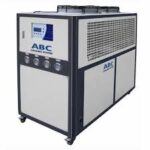
Spindle Chiller
Spindle Chiller are specialized cooling systems designed to manage the temperature of the spindle in machinery, such as CNC (Computer Numerical Control) machines.
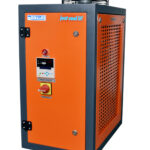
Refrigerated Air Dryer
Refrigerated Air Dryer is a type of device used in compressed air systems to reduce the moisture content of the air. It operates by cooling the compressed air to a temperature where water vapor condenses into liquid water.
